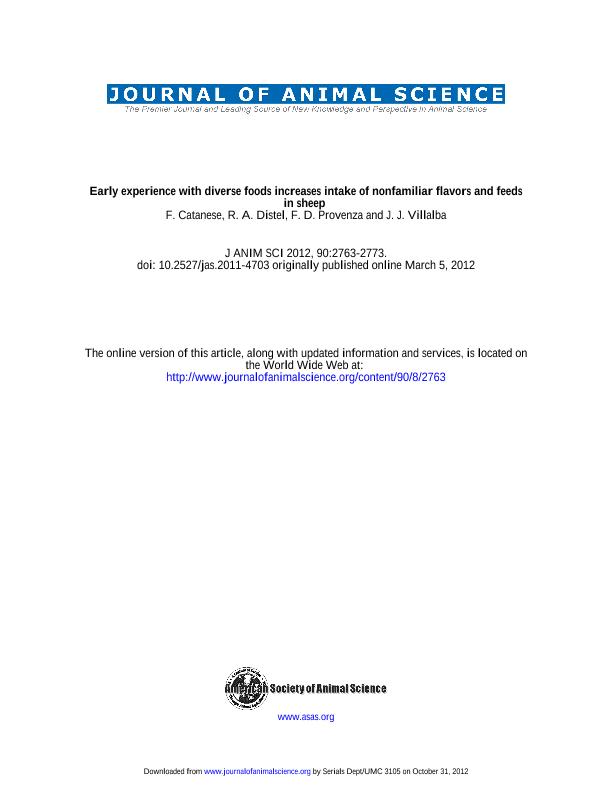Artículo
Early experience with diverse foods increases intake of nonfamiliar flavors and feeds in sheep
Fecha de publicación:
08/2012
Editorial:
American Society of Animal Science
Revista:
Journal of Animal Science
ISSN:
0021-8812
Idioma:
Inglés
Tipo de recurso:
Artículo publicado
Clasificación temática:
Resumen
This study determined whether early experiences by sheep with monotonous or diverse diets influence intake of unfamiliar flavors and feeds later in life. Thirty 2-mo-old lambs were randomly assigned to 3 treatment diets (n = 10): diverse (DIV), diverse with plant toxins (DIV+T), and monotonous (MON). Lambs in DIV received in 9 successive periods of exposure 4-way choice combinations of 2 foods high in energy and 2 foods high in protein from an array of 6 foods: 3 high in energy [beet pulp, oat grain, and a mix of milo:grape pomace (60:40)] and 3 high in digestible protein (DP) (soybean meal, alfalfa, corn gluten meal). Lambs in DIV+T received the same exposure as DIV, but 2 plant toxins, oxalic acid (1.5%) and quebracho tannins (10%), were randomly added to 2 of the feeds in each of the choice combinations. Lambs in MON received a monotonous balanced diet, made with a mixture of all 6 feeds detailed before. All treatments received their feed in 4 separate buckets. During exposure, treatments did not differ in total daily DMI (P = 0.31), but daily intake of ME was less (P < 0.02) and daily intake of DP was greater (P < 0.03) for lambs in DIV and DIV+T than for lambs in MON. Treatments did not differ in ADG or G:F (P > 0.05). After exposure, lambs were offered a familiar feed (wheat bran) containing novel flavors (maple, garlic, or bitter) and 2-way choices of novel feeds (fescue hay vs. corn distillers grains, rice vs. calf manna, and green peas vs. rolled oats). Intake of maple-flavored wheat bran tended (P = 0.08) to be greater for lambs in DIV than for lambs in DIV+T and MON. Intake of bitter-flavored and garlic-flavored wheat bran were greater (P = 0.03 and P = 0.04, respectively) for lambs in DIV and DIV+T than for lambs in MON. During 2-way choice trials, lambs in DIV, but not in DIV+T, showed greater intakes of fescue hay (P = 0.05) and rice (P = 0.04) than lambs in MON. Intake of green peas was greater (P = 0.03) for lambs in DIV and DIV+T than for lambs in MON. At the end of testing, lambs in DIV but not in DIV+T showed greater ADG than lambs in MON (P = 0.05). Thus, early exposure to diverse foods enhanced acceptance of novel flavors relative to early exposure to a monotonous ration. Early experience with diverse feeds plus plant toxins led to a less diverse diet than early experience with diverse feeds. Early exposure to diverse feeds may be beneficial in production systems that require rapid acceptance and high intake of unfamiliar feeds.
Palabras clave:
Dietary Diversity
,
Early Food Experience
,
Neophobia
,
Sheep
,
Diet Selection
Archivos asociados
Licencia
Identificadores
Colecciones
Articulos(CERZOS)
Articulos de CENTRO REC.NAT.RENOVABLES DE ZONA SEMIARIDA(I)
Articulos de CENTRO REC.NAT.RENOVABLES DE ZONA SEMIARIDA(I)
Citación
Catanese, Francisco Hernan; Distel, Roberto Alejandro; Provenza, F.; Villalba, J. J.; Early experience with diverse foods increases intake of nonfamiliar flavors and feeds in sheep; American Society of Animal Science; Journal of Animal Science; 90; 8; 8-2012; 2763-2773
Compartir
Altmétricas




